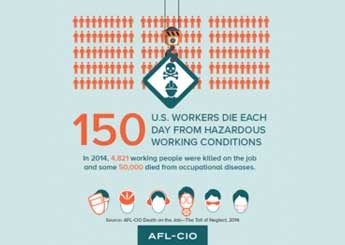During Workers’ Memorial Week, safety advocates call for stronger protections

Photo: The AFL-CIO
In recognition of Workers’ Memorial Week, which took place April 23-30, the AFL-CIO, National Council for Occupational Safety and Health and other organizations called for better protections for workers.
About 150 people die every day as a result of hazardous working conditions in the United States, the AFL-CIO noted in its annual report, “Death on the Job: The Toll of Neglect,” released April 27 in advance of Workers’ Memorial Day on April 28.
About 150 people die every day as a result of hazardous working conditions in the United States, The AFL-CIO noted in its annual report, Death on the Job: The Toll of Neglect, released April 27 in advance of Workers’ Memorial Day on April 28.
The death toll includes 4,821 workers who were killed on the job in 2014 (the most recent year for which data is available), as well as an estimated 50,000 people who died of occupational-related diseases.
The AFL-CIO says more than 532,000 workers’ lives have been saved since the passage of the Occupational Safety and Health Act of 1970, yet work-related fatalities and injuries remain “unacceptably high.” Twenty-five states recorded an increase in worker fatality rates from 2013 to 2014, and the national injury and illness rate in 2014 was 3.4 per 100 workers – up from 3.3 in 2013.
“The bottom line in all of this: some good, some bad,” The AFL-CIO Director of Safety and Health Peg Seminario said during a press conference following the release of the report. “But there are still too many workers being killed and injured on the job. We have a lot of work to do.”
Key findings in The AFL-CIO’s report include:
- Wyoming replaced North Dakota as the state with the highest worker fatality rate. North Dakota dropped to No. 2, followed by Alaska, South Dakota and Mississippi.
- 804 Latino workers were killed on the job in 2014.
- Workers 55 and older now represent 35 percent of all work fatalities.
- Workplace violence-related deaths increased – 765 deaths were recorded in 2014.
- The oil and gas industry experienced 144 deaths – the highest number of fatalities ever recorded among this worker group.
The government’s capacity to oversee and enforce safety and health measures has worsened since The AFL-CIO’s initial report 25 years ago, Seminario said. However, she praised OSHA for its recent publication of a final rule intended to protect workers from exposure to respirable crystalline silica. OSHA estimates the rule will save about 600 lives and prevent almost 1,000 cases of silicosis per year.
“I want to underscore what a huge victory that was for working people,” said Seminario, who applauded President Barack Obama, Secretary of Labor Thomas Perez and OSHA administrator David Michaels for their commitment to the silica rule. “This is going to make a huge difference for working people in the construction industry in particular, but in other industries as well.”
Another annual report on occupational fatalities, this one from the National Council for Occupational Safety and Health, was released on April 27. Highlights from the report, titled Preventable Deaths, include:
- Fatalities increased in the agriculture, construction, manufacturing and mining industries.
- Temporary and contract workers made up 16.7 percent of deaths, up seven percent from 2013.
- 818 deaths occurred from slips, trips and falls, a rise from 724 in 2013.
“In too many cases, employers are not meeting their legal obligation to provide safe working conditions,” National COSH Acting Executive Director Jessica Martinez said during a press conference. “We also know there are not enough OSHA inspectors. … We also know there is not proper training always available. We also know many times employers push productivity over safety.”
Martinez called for more research to better understand why older workers are at risk for occupational fatalities. In addition, she said, National COSH has collaborated with the National Staffing Workers Alliance and the American Public Health Association on recommendations for OSHA to improve protections for temporary workers.
“There is an increase in temp worker fatalities due to the reality of our economy that there are more temp jobs now,” Martinez said. “We need more regional focus, more local focus, more State Plans to help enforce and protect temp workers and really track down temp agencies and allow for dual employer accountability [with the host employer and temp agency] when protecting temp workers.”
The National Safety Council marked Workers' Memorial Day by releasing an infographic that calls attention to workplace injuries. The infographic notes that a worker is injured on the job every seven seconds.
“Every single worker should make it home, safe and sound, to their family every night,” John Dony, director of the Campbell Institute at the National Safety Council, said in a press release. “Clearly we are not doing enough to ensure that happens. On Workers’ Memorial Day we need to remember those we have lost and renew our commitment to safety so we can save lives and reverse this trend.”
Post a comment to this article
Safety+Health welcomes comments that promote respectful dialogue. Please stay on topic. Comments that contain personal attacks, profanity or abusive language – or those aggressively promoting products or services – will be removed. We reserve the right to determine which comments violate our comment policy. (Anonymous comments are welcome; merely skip the “name” field in the comment box. An email address is required but will not be included with your comment.)

